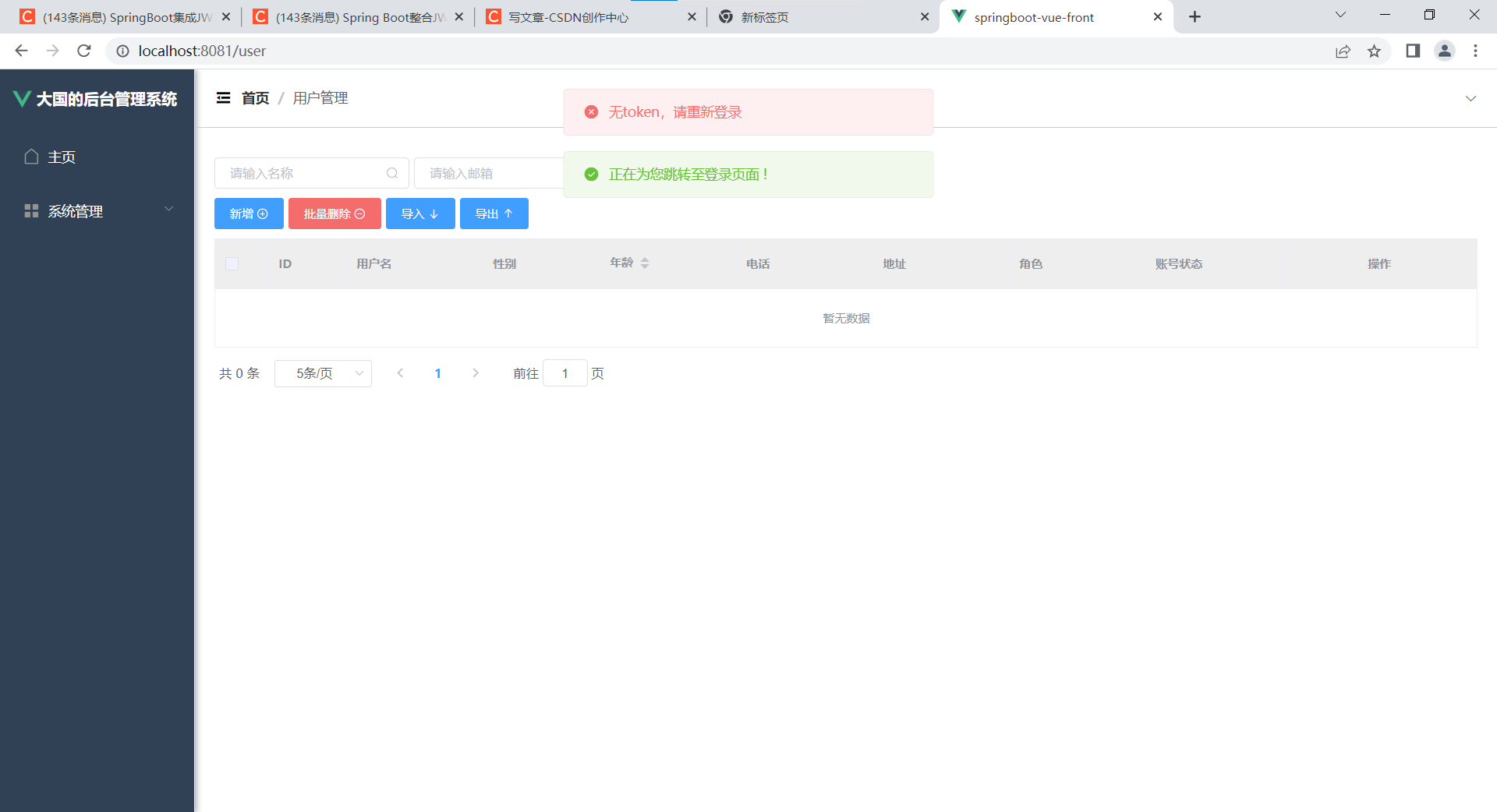JWT 简称 JSON Web Token,通过JSON形式作为Web应用中的令牌,用于各方之间安全地将信息作为JSON对象传输,在数据传输的过程中还可以完成数据加密、签名等相关处
优势所在
在JavaWeb阶段,经常使用session来存储,以方便用来判断用户是否操作等等。但这又恰巧暴露了一个问题,用session存储是需要占用服务器内存的。当用户只有一两个的时候没什么问题,但是当用户成千上万的话,服务器就很难招架得住了。并且session是基于cookie来实现的,因此数据很容易被截获,遭遇CSRF跨域伪造攻击,因此不太安全。这时JWT的优势就突显出来的:
简洁(Compact): 可以通过URL,POST参数或者在HTTP header发送,因为数据量小,传输速度也很快
自包含(Self-contained):负载中包含了所有用户所需要的信息,避免了多次查询数据库
因为Token是以JSON加密的形式保存在客户端的,所以JWT是跨语言的,原则上任何web形式都支持。
不需要在服务端保存会话信息,特别适用于分布式微服务。
使用
首先在maven中导入
<!-- JWT -->
<dependency>
<groupId>com.auth0</groupId>
<artifactId>java-jwt</artifactId>
<version>3.10.3</version>
</dependency>然后在utils包中创建TokenUtils
package com.example.utils;
import cn.hutool.core.date.DateUtil;
import cn.hutool.core.util.StrUtil;
import com.auth0.jwt.JWT;
import com.auth0.jwt.algorithms.Algorithm;
import com.example.entity.User;
import com.example.service.UserService;
import lombok.extern.slf4j.Slf4j;
import org.springframework.stereotype.Component;
import org.springframework.web.context.request.RequestContextHolder;
import org.springframework.web.context.request.ServletRequestAttributes;
import javax.annotation.PostConstruct;
import javax.annotation.Resource;
import javax.servlet.http.HttpServletRequest;
import java.util.Date;
@Component
@Slf4j
public class TokenUtils {
private static UserService staticUserService;
@Resource
private UserService userService;
@PostConstruct
public void setUserService() {
staticUserService = userService;
}
/**
* 生成token
*
* @return
*/
public static String genToken(String userId, String sign) {
return JWT.create().withAudience(userId) // 将 user id 保存到 token 里面,作为载荷
.withExpiresAt(DateUtil.offsetHour(new Date(), 2)) // 2小时后token过期
.sign(Algorithm.HMAC256(sign)); // 以 password 作为 token 的密钥
}
/**
* 获取当前登录的用户信息
*
* @return user对象
*/
public static User getCurrentUser() {
try {
HttpServletRequest request = ((ServletRequestAttributes) RequestContextHolder.getRequestAttributes()).getRequest();
String token = request.getHeader("token");
if (StrUtil.isNotBlank(token)) {
String userId = JWT.decode(token).getAudience().get(0);
return staticUserService.getById(Integer.valueOf(userId));
}
} catch (Exception e) {
return null;
}
return null;
}
}
然后在Crontroller或者ServiceImpl中的返回结果中加上Token
/**
* 用户登录
*
* @param userDto
* @return
*/
@PostMapping("/login")
public Result login(@RequestBody UserDto userDto) {
User dbUser = userService.checkLoginUserbyUsernameAndPassword(userDto); //返回的是根据userDto的用户名和密码查询数据库中的用户
if (dbUser==null){
return Result.error(Constants.CODE_400,"用户名或密码错误");
}
if (!dbUser.isStatus()){
return Result.error(Constants.CODE_401,"账号状态异常,请联系管理员");
}
UserDto tokenUser=new UserDto();
BeanUtils.copyProperties(dbUser,tokenUser);
String token = TokenUtils.genToken(dbUser.getId().toString(), dbUser.getPassword());
tokenUser.setToken(token);
return Result.success(tokenUser);
}此时返回给前端的结果中就有了一串Token

然后在前端封装的request.js中添加条件 ,每次请求都需携带Token
import router from '@/router';
import axios from 'axios'
import ElementUI from 'element-ui';
const request = axios.create({
baseURL: 'http://localhost:9090',
timeout: 5000
})
// request 拦截器
// 可以自请求发送前对请求做一些处理
// &&比如统一加token,对请求参数统一加密
request.interceptors.request.use(config => {
config.headers['Content-Type'] = 'application/json;charset=utf-8';
let user = localStorage.getItem("user") ? JSON.parse(localStorage.getItem("user")) : null
if (user) {
config.headers['token'] = user.token; // 设置请求头
}
return config
}, error => {
return Promise.reject(error)
});
// response 拦截器
// 可以在接口响应后统一处理结果
request.interceptors.response.use(
response => {
let res = response.data;
// 如果是返回的文件
if (response.config.responseType === 'blob') {
return res
}
// 兼容服务端返回的字符串数据
if (typeof res === 'string') {
res = res ? JSON.parse(res) : res
}
// **当权限验证不通过的时候给出提示
if (res.code === '401') {
ElementUI.Message({
message: res.msg,
type: 'error',
});
//2s后跳转到登录页面
setTimeout(() => {
ElementUI.Message({
message: '正在为您跳转至登录页面 ! ',
type: 'success',
});
}, 1000);
//2s后跳转到登录页面
setTimeout(() => {
location.href = 'http://localhost:8081/login';
}, 2500);
}
return res;
},
error => {
console.log('err' + error) // for debug
return Promise.reject(error)
}
)
export default request

设置拦截器拦截前端传来的所有请求
package com.example.config;
import com.example.config.interceptor.JwtInterceptor;
import org.springframework.context.annotation.Bean;
import org.springframework.context.annotation.Configuration;
import org.springframework.web.servlet.config.annotation.InterceptorRegistry;
import org.springframework.web.servlet.config.annotation.WebMvcConfigurer;
@Configuration
public class InterceptorConfig implements WebMvcConfigurer {
@Override
public void addInterceptors(InterceptorRegistry registry) {
registry.addInterceptor(jwtInterceptor())
.addPathPatterns("/**") // 拦截所有请求,通过判断token是否合法来决定是否需要登录
.excludePathPatterns("/user/login", "/user/register", "/**/export", "/**/import"); //过滤的请求
}
@Bean
public JwtInterceptor jwtInterceptor() {
return new JwtInterceptor();
}
}对拦截到的请求进行处理 校验token
package com.example.config.interceptor;
import cn.hutool.core.util.StrUtil;
import com.auth0.jwt.JWT;
import com.auth0.jwt.JWTVerifier;
import com.auth0.jwt.algorithms.Algorithm;
import com.auth0.jwt.exceptions.JWTDecodeException;
import com.auth0.jwt.exceptions.JWTVerificationException;
import com.example.common.Constants;
import com.example.entity.User;
import com.example.exception.CustomException;
import com.example.service.UserService;
import org.springframework.web.method.HandlerMethod;
import org.springframework.web.servlet.HandlerInterceptor;
import javax.annotation.Resource;
import javax.servlet.http.HttpServletRequest;
import javax.servlet.http.HttpServletResponse;
public class JwtInterceptor implements HandlerInterceptor {
@Resource
private UserService userService;
@Override
public boolean preHandle(HttpServletRequest request, HttpServletResponse response, Object handler) throws Exception {
String token = request.getHeader("token");
// 如果不是映射到方法直接通过
if(!(handler instanceof HandlerMethod)){
return true;
}
// 执行认证
if (StrUtil.isBlank(token)) {
throw new CustomException(Constants.CODE_401, "无token,请重新登录");
}
// 获取 token 中的 user id
String userId;
try {
userId = JWT.decode(token).getAudience().get(0);
} catch (JWTDecodeException j) {
throw new CustomException(Constants.CODE_401, "token验证失败,请重新登录");
}
// 根据token中的userid查询数据库
User user = userService.getById(userId);
if (user == null) {
throw new CustomException(Constants.CODE_401, "用户不存在,请重新登录");
}
// 用户密码加签验证 token
JWTVerifier jwtVerifier = JWT.require(Algorithm.HMAC256(user.getPassword())).build();
try {
jwtVerifier.verify(token); // 验证token
} catch (JWTVerificationException e) {
throw new CustomException(Constants.CODE_401, "token验证失败,请重新登录");
}
return true;
}
}
如果登录状态下 密码被篡改 那么token也会改变 退回到登录页面
效果:
























 1486
1486











 被折叠的 条评论
为什么被折叠?
被折叠的 条评论
为什么被折叠?










